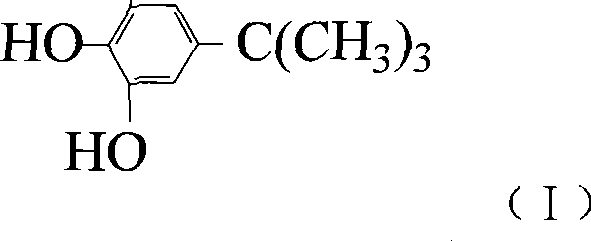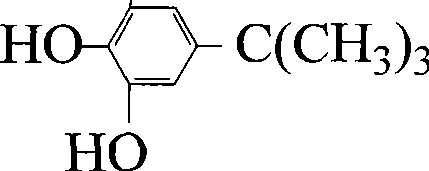Preparation technique for polymerization inhibitor products
A preparation process and technology of a polymerization inhibitor, applied in the field of preparation technology of a polymerization inhibitor product, can solve the problems of unsatisfactory process method, inconvenience for industrialized production, large instantaneous reaction heat release, etc., and achieves convenient industrial production and production. Low cost and high conversion rate
- Summary
- Abstract
- Description
- Claims
- Application Information
AI Technical Summary
Problems solved by technology
Method used
Image
Examples
Embodiment 1
[0053] In a GST-2 type 2000mL stainless steel autoclave with a magnetic stirrer and a 1000mL isobutylene metering tank, 600 grams (5.455 mol) of catechol and 18 grams of activated LCS-7 catalyst were sequentially added. The air in the autoclave was replaced with nitrogen. Turn on the heating power to slowly heat up the material in the kettle. When the temperature in the kettle reaches 110℃, after the catechol in the kettle is completely melted, start the stirrer and adjust the rotation speed to 700-750 rpm. When the temperature rises to 115-118°C, the valve of the isobutene metering tank is opened, and the isobutene raw material is continuously added into the reaction kettle. While stirring, add materials, and maintain a constant temperature of 115-118 ° C in the reactor. 305 g (5.455 mol) of isobutene was added in 150 minutes, and the pressure in the kettle during the addition was 0.02-0.08 MPa. Under this condition, catechol and isobutylene undergo an alkylation reaction,...
Embodiment 2
[0057] In a GST-2 type 2000mL stainless steel autoclave with a magnetic stirrer and a 1000mL isobutene metering tank, 600 grams (5.455 mol) of catechol and 12 grams of activated LCS-7 catalyst were sequentially added. The air in the autoclave was replaced with nitrogen. Turn on the heating power to slowly heat up the material in the kettle. When the temperature in the kettle reaches 110℃, after the catechol in the kettle is completely melted, start the stirrer and adjust the rotation speed to 700-750 rpm. When the temperature rises to 120-123°C, the valve of the isobutene metering tank is opened, and the isobutene raw material is continuously added into the reaction kettle. While stirring, add materials, and maintain a constant temperature of 120-123 ° C in the reactor. 305 g (5.455 mol) of isobutene was added in 120 minutes, and the pressure in the kettle during the addition was 0.02-0.08 MPa. Under this condition, catechol and isobutylene undergo an alkylation reaction, a...
Embodiment 3
[0060] In a GST-2 type 2000mL stainless steel autoclave with a magnetic stirrer and a 1000mL isobutene metering tank, 600 grams (5.455 mol) of catechol and 24 grams of activated LCS-7 catalyst were sequentially added. The air in the autoclave was replaced with nitrogen. Turn on the heating power to slowly heat up the material in the kettle. When the temperature in the kettle reaches 110℃, after the catechol in the kettle is completely melted, start the stirrer and adjust the rotation speed to 700-750 rpm. When the temperature rises to 128-130°C, the valve of the isobutene metering tank is opened, and the isobutene raw material is continuously added into the reaction kettle. While stirring, add materials, and maintain a constant temperature of 128-130 ° C in the reactor. 336 grams (6.000 mol) of isobutene was added in 180 minutes, and the pressure in the kettle was 0.02-0.08 MPa during the addition. Under this condition, catechol and isobutylene undergo an alkylation reactio...
PUM
| Property | Measurement | Unit |
|---|---|---|
| melting point | aaaaa | aaaaa |
| melting point | aaaaa | aaaaa |
| melting point | aaaaa | aaaaa |
Abstract
Description
Claims
Application Information
 Login to View More
Login to View More - R&D
- Intellectual Property
- Life Sciences
- Materials
- Tech Scout
- Unparalleled Data Quality
- Higher Quality Content
- 60% Fewer Hallucinations
Browse by: Latest US Patents, China's latest patents, Technical Efficacy Thesaurus, Application Domain, Technology Topic, Popular Technical Reports.
© 2025 PatSnap. All rights reserved.Legal|Privacy policy|Modern Slavery Act Transparency Statement|Sitemap|About US| Contact US: help@patsnap.com



